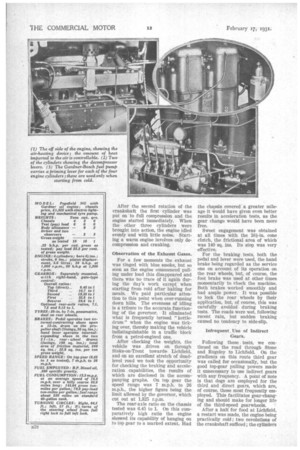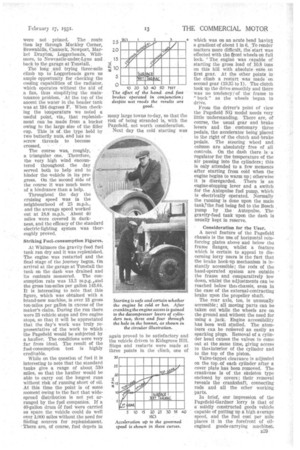A 100-mile Trial of AN OIL-ENGINED LORRY
Page 55

Page 56

Page 57

If you've noticed an error in this article please click here to report it so we can fix it.
The Performance of the 6-ton Pagefield-Gardner when Tested Over a Hilly Course in the Midlands. Marked Fuel Economy
WTIEN the Garclher-engined Pagelield "6-ton lorry was introduced a few 'ninths ago it was fully described in the pages of The Commercial Motor. ..41. the time it aroused considerable interest, because it was not merely a conversion of a petrol-engined chassis, but was designed from the start. to incorporate an oil engine. The chassis possesses many interesting fea
tares, and it is our purpose here to describe the results of the design as evidenced by the performance obtained when subjected to our standard "cOmprehensive road test.
As handed over to us; the NO-type Fagefield chassis had but 50 miles to its credit. A temporary cab was provided, and the load, consisting of ballast boxes and a metal block, was carried upon wooden longitudinal bearers anchored to the chassis. The load was 6 tons DI cwt., so that when the driver's apd observer's weights are added the machine will be seen to have been laden to the full pay load, plus a body allowance.
A British-built Machine.
The vehicle was taken over by arrangement with Pagetield Commercial. Vehicles, Ltd., 1,,eybourne House, Regent Street, Stoke-onTrent, the factory of which is situated at Wigan. The Gardner oil engine is of course, made by L. Gardner and Sons, Ltd., Patricroft, Manchester.
A start was made from a garage in Tunstall, and the Autopulse pump was put out of action by disconnection of the pipes. The day's work was carried out using only the gravity-feed fuel tank on the dashboard, so that an accurate check could be kept upon consumption. En route for the open country the vehicle was run on to a weighbridge ; the Agues obtained appear in the accompanying• panel. • Before proceeding farther, tlik ease of starting deserves attention. The water in the radiator prior to the first start was at 46 degrees F., and the air temperature was 54 degrees F. The starting procedure at the beginning only of each day consisted of pressing a button on the fuel pump to lengthen the stroke and then the various cylinders were primed by means of the levers along side the fuel pump ; cylinders two, three and four were decompressed by actuation of the levers on the cylinder heads. The engine was then started by means of the handle, momentum being obtained by decompressing cylinder No. 1 by means of a 'lever beside the starting handle. After the second rotation of the crankshaft the first cylinder was put on to full compression and the engine started immediately. When the other three cylinders were brought into action, the engine idled evenly and with little noise. Starting a warm engine involves only decompression and cranking.
Observation of the Exhaust Gases.
For a few moments the exhaust was tinged with blue smoke, but so soon as the engine commenced pulling under load this disappeared and there was no trace of it again during the day's work except when starting from told after halting for meals. We paid particular attention to this point when over-running down hills. The evenness of idling is a tribute to the accurate functioning of the governor. It eliminated what is frequently termed "kettledrum" when the engine was ticking over, thereby making the vehicle indistinguishable in a traffic block from a petrol-engined one.
After checking the weights, the vehicle was driven on through Stoke-on-Trent towards, Lichfield, and on an excellent stretch of deadlevel road we took the opportunity for checking the braking and acceleration capabilities, the results of which are disclosed in the accompanying graphs. On top gear the speed range was 7 m.p.h. to 26 m.p.h., the higher figure being the limit allowed by the governor, which cut out at 1,325 r.p.m.
The rear-axle ratio on the chassis tested was 6.45 to 1. On this comparatively high ratio the engine showed its capability of hanging on to top gear to a marked extent. Had the chassis covered a greater mileage it would have given even better results in acceleration tests, as the gear change would have been more free.
Sweet engagement was obtained at all times with the 161-in, cone clutch, the frictional area of which was 140 sq. ins. Its stop was very effective.
For the braking tests, both the pedal and lever were used, the hand brake being regarded as the service one on account of its operation on the rear wheels, but, of course, the foot brake was used at other times momentarily to cheek the machine. Both brakes worked smoothly and had ample power. It was possible to lock the rear wheels by their application, but, of course, this was carefully avoided during braking tests. The roads were wet, following recent rain, but sudden braking caused no tendency to side-slip.
Infrequent Use of Indirect Gears.
Following these tests, we continued on the road through Stone and Rugeley to Lichfield. On the gradients on this route third gear was called for occasionally, but the good top-gear pulling powers made it unnecessary to use indirect gears with any frequency. A point of note is that dogs are employed for the third and direct gears, which are, of course, those most frequently employed. This facilitates gear-changing and should make for longer life of the third-speed gearwheels.
After a halt for food at Lichfield, a restart was made, the engine being practically cold; two revolutions of the crankshaft sufficed ; the cylinders
were not primed. The route then lay through Muckley Corner, Brownhills, Cannock, Newport, Market Drayton, Loggerheads, Whitmore, to Newcastle-under:Lytle and back to the garage at Tunstall. The long and trying three-mile climb up to Loggerheads gave us ample opportunity for checking the cooling capabilities of the radiator, which operates without the aid of a fan, thus simplifying the maintenance problem.At the top of the aScent the water in the header tank was at 194 degrees F. When checking the temperature we noted a useful point, viz., that replenishment can be made from a bucket owing to the large size of the filler cap. This is of the type held by two butterfly nuts, and has no screw threads to become crossed.
The course was, roughly, a triangular one. Therefore, the very high wind encountered throughout the day served both to help and to hinder the -vehicle in its progress. On the second side of the course it was much more of a hindrance than a help.
Throughout the day the cruising speed was in the neighbourhood of 25 m.p.h., and the average speed worked out at 18.8 m.p.h. About 40 miles were covered in darkness, and the efficacy of the standard electric-lighting system was thoroughly proved.
Striking Fuel-consumption Figures.
At Whitmore the gravity-feed fuel tank ran dry and it was replenished. The engine was restarted and the final stage of the journey begun. On arrival at the garage at Tunstall the tank on the dash was drained and its contents measured. The consumption rate was 13.3 m.p.g.,and the gross ton-miles per gallon 143.64. It is interesting to note that this figure, which was obtained with a brand-new machine, is over 13 gross ton-miles per gallon in excess of the maker's claim. During the run there were 23 vehicle stops and five engine stops, so that it will he appreciated that the day's work was truly representative of the work to which the Pagefield would be subjected by a haulier. The conditions were very far from ideal. The result of the fuel-consumption test is highly creditable.
While on the question of fuel it is interesting to note that the standard tanks give a range of about 530 miles, so that the haulier would be able to carry out the longest runs without risk of running short of oil. At this time the point is of some moment awing to the fact that widespread distribution is not yet arranged by the fuel companies. If a 40-gallon drum of fuel were carried as spare the vehicle could do well over 1,000 miles without the need for finding sources for replenishment.
• There are, of course, fuel depots in
many large towns to-day, so that the risk of being stranded is, with the Pagefield, not worth consideration. Next day the cold starting was
-again proved to be satisfactory and the vehicle driven to Kidsgrove Hill. Stops and restarts were made at three points in the tlimb, one of
which was on an acute bend havin3 a gradient of about 1-in 6. To render matters more difficult, the start was effected with the front wheels on full lock. The engine was capable of starting the gi-oss load of 10.8 tons on this hill with absolute ease-: first first gear. At the other points in the climb a restart was made on second gear (19.35 to 1). The clutch took up the drive smoothly and there was no tendency of the frame to " buck " as the wheels began to drive.
From the driver's point of view the Pagefield NG model needs very little understanding. There are, of course, the usual gear and brake levers and the customary .three pedals,the accelerator being placed to the right of the clutch and •brake pedals. The steering wheel and column are absolutely free of all controls. On the dash there is , a regulator for the temperature of the air passing into the cylinders ; this is only attended to a few moments after starting from cold when the engine begins to warm up ; otherwise it is disregarded. There is an engine-stopping lever and a switch for the Autopulse fuel pump, which is electilcally operated. Normally the running -is done upon the main tank,qhe fuel being fed to the Bosch pump by the Autopulse. The gravity-feed tank upon the dash is usually kept in reserve.
• Consideration for the User.
A novel feature of the Pagefield chassis is the use.of horizontal reinforcing plates above and below the frame flanges, whilst a feature which is certain to appeal to discerning lorry users is the fact that the brake hook-up mechanism is instantly accessible; the rods of the hand-operated system are outside the frame and comparatively low down, whilst the adjustments can be reached below thea chassis, even in the case of the external-contracting brake upon the propeller shaft.
The rear axle, too, is unusually accessible; all moving parts can be taken out while the wheels are on the ground andwithout the need for using a jack. Engine accessibility has been well studied. The atomizers can be removed as easily as sparking plugs. Removal of a cylinder head causes the valves to come out at the same time, giving access to the-kinterior of the cylinder and to the top of the piston.
Valve-tappet clearance is adjusted on the top . of each cylinder after a cover plate has been removed. The crankcase is of the skeleton type enclosed by covers ; their removal reveals the crankshaft, connecting rods and all the other working parts.
In brief, our impression of the Pagefield-Gardner lorry is that of a solidly constructed goods vehicle capable of putting up a high average speed, and the fuel cost per mile places it in the forefront of oilengined goods-carrying machines.






















































































































